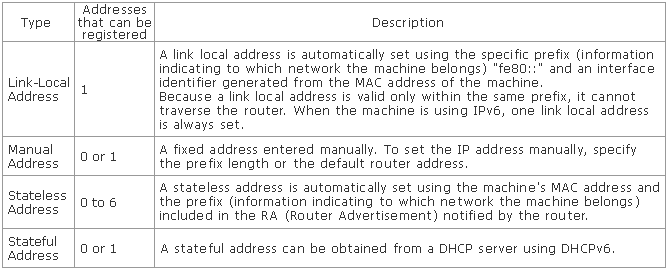Setting the IP Address
| Article ID: ART141906 | | | Date published: 05/13/2015 | | | Date last updated: 08/17/2015 |
Description
Setting the IP Address
Solution
| Setting the IP Address ID : 8201921200 _ EN _ 1 | |||||
| Solution | Setting IPv4 Address
By default, the IPv4 address is obtained automatically. Follow the steps in the procedure below to change the IP address setting. 1. Press [  ] (Menu). ] (Menu).2. Select <Network Settings> using [  ] or [ ] or [  ], and then press [OK]. ], and then press [OK].  When the system manager ID and system manager PIN are specified When the system manager ID and system manager PIN are specifiedUse the numeric keys to enter the ID and number, and then press [  ] (Log In/Out). ] (Log In/Out). 3. Select <TCP/IP Settings> using [  ] or [ ] or [  ], and then press [OK]. ], and then press [OK]. 4. Select <IPv4 Settings> using [  ] or [ ] or [  ], and then press [OK]. ], and then press [OK]. 5. Select <IP Address Settings> using [  ] or [ ] or [  ], and then press [OK]. ], and then press [OK]. 6. Select the method for setting the IP address using [  ] or [ ] or [  ]. ].
7. Change the IP address settings.
 When <Auto Obtain> is selected When <Auto Obtain> is selected7-A-1. Change <Auto Obtain> settings.
- <Off> Do not obtain an IP address automatically. - <DHCP> Obtain an IP address automatically using DHCP. (The DHCP server needs to be running.) - <BOOTP> Obtain an IP address automatically using BOOTP. (The BOOTP daemon needs to be running.) - <RARP> Obtain an IP address automatically using RARP. (The RARP daemon needs to be running.)
- <Off> Do not obtain an IP address automatically. - <On> Obtain an IP address automatically. 7-A-2. Select <Apply> using [  ] or [ ] or [  ], and then press [OK]. ], and then press [OK].  When <Manual Obtain> is selected When <Manual Obtain> is selectedThis setting can be specified only when <Select Protocol> and <Auto IP> in <Auto Obtain> are set to <Off>.  7-B-1. Enter the IP address. (See "Text Input Method") After it has been entered, press [OK].  7-B-2. Enter the subnet mask. (See "Text Input Method") After it has been entered, press [OK].  7-B-3. Enter the gateway address. (See "Text Input Method") After it has been entered, press [OK].  8. Press [  ] (Menu) to close the menu screen. ] (Menu) to close the menu screen.9. Restart the machine. Turn OFF the machine and wait for at least 10 seconds before turning it back ON. Setting IPv6 Address
Specify IPv6 settings using the Remote UI after you have specified the IPv4 settings. 1. Start the Remote UI and log on in system manager mode. See the "e-Manual" (HTML manual) in the CD-ROM supplied with the machine. 2. Click [Settings/Registration]. 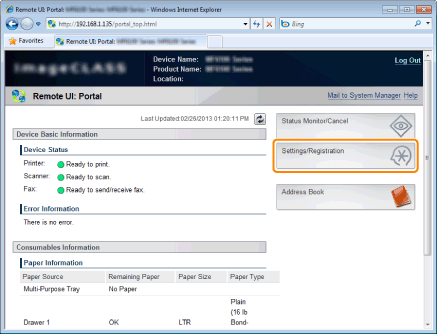 3. Click [Network Settings] -> [TCP/IP Settings]. 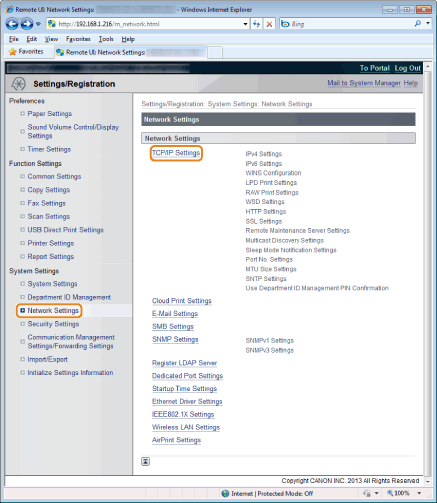 4. Click [Edit] in [IPv6 Settings]. 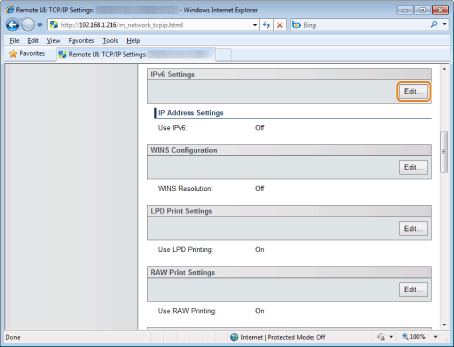 5. Select the [IPv6] check box. 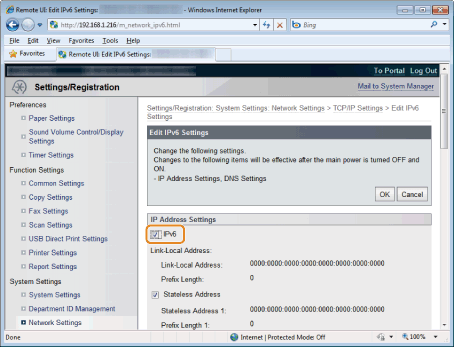 6. Specify the stateless address. Clear the [Stateless Address] check box when not using a stateless address.  7. Follow the steps in the procedure below to use a manual address. Proceed to Step 8 when not using a manual address.
(1) Select the [Manual Address] check box. 8. Set DHCPv6. Select the [Use DHCPv6] check box to use stateful DHCPv6. 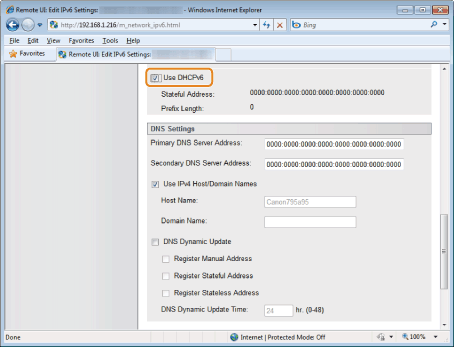 9. Click [OK]. 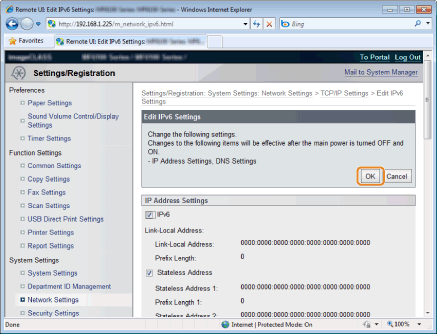 10. Restart the machine. Turn OFF the machine and wait for at least 10 seconds before turning it back ON. Checking IP Address Settings
 Checking IPv4 address settings Checking IPv4 address settings1. Press [  ] (Status Monitor/Cancel). ] (Status Monitor/Cancel).2. Select <Network Information> using [  ] or [ ] or [  ], and then press [OK]. ], and then press [OK]. 3. Select <IPv4> using [  ] or [ ] or [  ], and then press [OK]. ], and then press [OK]. 4. Select the setting to check using [  ] or [ ] or [  ], and then press [OK]. ], and then press [OK]. 5. Check the information.  6. Press [  ] (Status Monitor/Cancel) to close the screen. ] (Status Monitor/Cancel) to close the screen. Checking IPv6 address settings Checking IPv6 address settings1. Press [  ] (Status Monitor/Cancel). ] (Status Monitor/Cancel).2. Select <Network Information> using [  ] or [ ] or [  ], and then press [OK]. ], and then press [OK]. 3. Select <IPv6> using [  ] or [ ] or [  ], and then press [OK]. ], and then press [OK]. 4. Select the setting to check using [  ] or [ ] or [  ], and then press [OK]. ], and then press [OK]. 5. Check the information.  6. Press [  ] (Status Monitor/Cancel) to close the screen. ] (Status Monitor/Cancel) to close the screen.Checking the Network Connection
Make sure that the network settings are correctly specified. 1. Press [  ] (Menu). ] (Menu).2. Select <Network Settings> using [  ] or [ ] or [  ], and then press [OK]. ], and then press [OK].  When the system manager ID and system manager PIN are specified When the system manager ID and system manager PIN are specifiedUse the numeric keys to enter the ID and number, and then press [  ] (Log In/Out). ] (Log In/Out). 3. Select <TCP/IP Settings> using [  ] or [ ] or [  ], and then press [OK]. ], and then press [OK]. 4. Select <IPv4 Settings> using [  ] or [ ] or [  ], and then press [OK]. ], and then press [OK]. 5. Select <PING Command> using [  ] or [ ] or [  ], and then press [OK]. ], and then press [OK]. 6. Enter an arbitrary IPv4 address existing on the network. After it has been entered, press [OK].  7. Check the response.  When the network connection is confirmed When the network connection is confirmed<Received response from host.> is displayed.  When the network connection is not confirmed When the network connection is not confirmed<No response from host.> is displayed. Recheck your network settings. 8. Press [  ] (Menu) to close the menu screen. ] (Menu) to close the menu screen. | ||||
| Related Info | Basic Network Settings | ||||
SIMS Doc Id
8201921200

